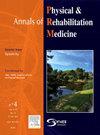Pericapsular hip chemical denervation with phenol: A case report suggesting the interest of this new tool in rehabilitation medicine
IF 4.6
3区 医学
Q1 REHABILITATION
Annals of Physical and Rehabilitation Medicine
Pub Date : 2025-04-29
DOI:10.1016/j.rehab.2025.101982
引用次数: 0
Abstract
Introduction
Hip pain is a frequent complaint in Physical and Rehabilitation Medicine. The cause is often joint degradation, often exacerbated by the consequences of neurological or orthopedic conditions. Surgical treatment is not always feasible in fragile patients. When medical treatment is insufficient, the result is loss of autonomy. Based on an innovative technique of locoregional anaesthesia (PEricapsular Nerve Group block or PENG block) and recently adapted with phenol, our multidisciplinary team used it to improve function.
Observation
The case reported here is that of a 25-year-old woman presenting with luxating dysplasia of the right hip in the context of Costello syndrome. The main symptom reported was right hip pain with functional discomfort on walking. Medical treatment was only temporarily effective. The benefit/risk balance was unfavorable to surgery due to the young age and degree of dysplasia. In this context, phenol neurolysis of the hip pericapsular nerve group was performed, preceded by a prognostic anesthetic block. The procedure resulted in complete disappearance of hip pain and resumption of walking.
Discussion
The achievement of complete analgesia and recovery of the previous functional level in this case give this procedure prospects for use in clinical practice in physical medicine and rehabilitation. Chemical denervation of the anterior hip joint capsule is a simple, inexpensive procedure whose efficacy can be assessed beforehand by a prognostic anesthetic block. This procedure provides pain relief for frail patients, minimizing their loss of function while avoiding the risks of surgery.
Conclusion
Pericapsular hip chemical denervation appears to be an interesting alternative in the management of hip pain in therapeutic impasse, as it is likely to improve autonomy and even restore previous functional status.
用苯酚进行髋关节囊包膜化学去神经支配:一个病例报告表明这种新工具在康复医学中的兴趣
髋关节疼痛是物理与康复医学中常见的主诉。其原因通常是关节退化,通常因神经或骨科疾病的后果而加剧。对于身体脆弱的病人,手术治疗并不总是可行的。当医疗治疗不足时,结果是丧失自主权。基于一种创新的局部区域麻醉技术(囊周神经阻滞或PENG阻滞),最近我们的多学科团队将其用于改善功能。本文报告的病例是一名25岁的女性,在Costello综合征的背景下表现为右髋关节脱位性发育不良。报告的主要症状是右髋关节疼痛和行走时的功能性不适。医疗只是暂时有效。由于年龄小和发育不良的程度,获益/风险平衡不利于手术。在这种情况下,对髋关节囊周神经组进行苯酚神经松解术,之前进行预后麻醉阻滞。手术后髋关节疼痛完全消失,恢复行走。本病例的完全镇痛和功能水平的恢复为该手术在物理医学和康复治疗中的临床应用提供了前景。髋关节前囊的化学去神经支配是一种简单、廉价的手术,其疗效可以通过预后麻醉阻断预先评估。这一过程为身体虚弱的患者提供疼痛缓解,最大限度地减少他们的功能丧失,同时避免手术的风险。结论髋关节囊包膜化学去神经支配是治疗髋关节疼痛的一种有趣的替代方法,因为它可能提高自主性,甚至恢复先前的功能状态。
本文章由计算机程序翻译,如有差异,请以英文原文为准。
求助全文
约1分钟内获得全文
求助全文
来源期刊

Annals of Physical and Rehabilitation Medicine
Medicine-Rehabilitation
CiteScore
7.80
自引率
4.30%
发文量
136
审稿时长
34 days
期刊介绍:
Annals of Physical and Rehabilitation Medicine covers all areas of Rehabilitation and Physical Medicine; such as: methods of evaluation of motor, sensory, cognitive and visceral impairments; acute and chronic musculoskeletal disorders and pain; disabilities in adult and children ; processes of rehabilitation in orthopaedic, rhumatological, neurological, cardiovascular, pulmonary and urological diseases.
 求助内容:
求助内容: 应助结果提醒方式:
应助结果提醒方式:


